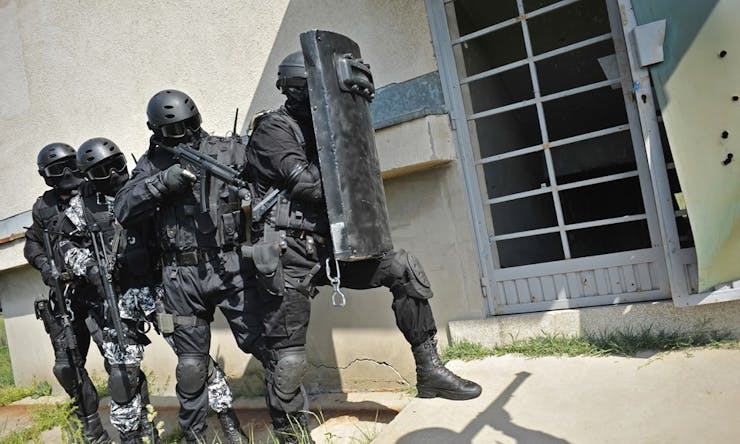Nearly 20 years ago, California became the first state to give patients legal access to medical marijuana. It happened with a voter initiative that was short and simple enough to fit on the back of a postcard. And ever since, locals’ relationship with federal law enforcement has been thorny, plagued by waves of FBI and DEA raids in which authorities seize property, break up families and put well-intentioned citizens behind bars.
As a thoughtful piece in the Los Angeles Times last week shows, it’s a pattern that has continued even as other states have implemented their own policies with comparatively little pushback from the feds. While hundreds of millions of dollars in cannabis is now freely bought and sold in recreational states, federal prosecutors continue to pursue cases in California.
So what accounts for the difference?
It’s easy to fault U.S. officials. Federal law regulates cannabis more tightly than opium or cocaine. But while the government’s position is extreme, that’s not the whole story. People on all sides of the issue admit that California law itself is largely to blame. And with more than a dozen states eyeing cannabis legalization in one form or another this year, there are lessons to be learned from the Golden State.
Consider the 1996 initiative that first allowed medical marijuana there. It’s extremely short, and while it clearly protected patients from legal penalties, it left basic questions unanswered: Where were patients supposed to obtain cannabis? How much could they have? And what specific ailments qualify?
The biggest gaps were around growth and distribution. So in 2003 the Legislature passed the cheekily named Senate Bill 420, allowing patients to “associate … in order collectively or cooperatively to cultivate marijuana for medical purposes.” But the law never explained what that meant.
“The early medical marijuana laws were Trojan horses designed to allow effective legalization for anyone who could fake an ache,” Carnegie Mellon University public policy professor Jonathan Caulkins told the L.A. Times. “California is in that category.”
As a lawyer described it to me during the height of the federal crackdown, state lawmakers failed to delineate clearly what was and wasn’t allowed. “They’ve designed an inherently ambiguous system to allow people to enact whatever they want,” said Todd R. Wulffson of Greenberg Traurig. “From a pragmatic standpoint, it leaves everyone kind of in the lurch. And until someone tests it in court, it’s difficult to know what will fly and what won’t.”
Here’s a fun fact: Even when dispensaries in California reportedly outnumbered Starbucks or McDonald’s outlets, officials weren’t sure whether they were allowed under state law. Over the course of just a few months, one court ruling prevented a city from banning dispensaries while another ruling called them flat-out illegal.
That’s a big reason things get hairy with the feds. The Department of Justice and now Congress have announced the government won’t go after cannabis operations that comply with state law, but in California it’s not always clear what that means.
Shop highly rated dispensaries near you
Showing you dispensaries nearAnd even when growers or dispensaries make every effort to comply, prosecutors accuse owners of “hijacking” state law to sell cannabis to just about anybody. Experts say the wide scope of California’s medical law has motivated prosecutions of respected dispensaries like Oakland’s Harborside Health Center, the nation’s largest.
As the Times reports:
Even in the case of Harborside, which state and local officials often hold up as a gold standard for the medical marijuana business, California’s loose rules about who is permitted to buy medical pot have left the operations a natural target for prosecutors, Caulkins said.
‘Harborside is gigantic, and the Justice Department thinks it is not providing marijuana just for kids with epilepsy or people with cancer or people with HIV,’ Caulkins said.
States that have more recently adopted medical marijuana provisions are not seeing their legitimate medical marijuana businesses targeted because they serve a much narrower group of clients, he said.
Legislative changes could slow prosecutions. Two federal lawmakers from California, U.S. Reps. Sam Farr and Dana Rohrabacher, teamed up in 2014 to pass a measure that prevents prosecutors from targeting anyone selling medical cannabis legally under state law. Local officials have cited that change, known as the Rohrabacher–Farr amendment, in efforts to curb federal cases from proceeding. They’re starting to get traction in courts, but prosecutors don’t show any sign of relenting.
Changes to California law could also help clarify what it means to be state compliant. Gov. Jerry Brown has signed three measures to clean up existing laws, but they don’t take effect until 2018. And initiatives to legalize cannabis recreationally are headed to the 2016 ballot.
It’s easy to see legal cases as statistics, measured by fluctuations in the number of businesses here or there. But prosecutions don’t simply close stores or shut down growers. Aaron Sandusky, who operated medical dispensaries in Southern California, is currently serving a 10-year prison sentence, the minimum under federal guidelines. He’s expected to be released on May 8, 2021.
Two decades ago, California led the nation in legalizing cannabis. As other states weigh their options, it’s important to learn from those early experiments — and their side effects. Voters might agree cannabis should be legal, but it’s still hard to iron out how to reasonably regulate the stuff. What do we want legalization to look like?





